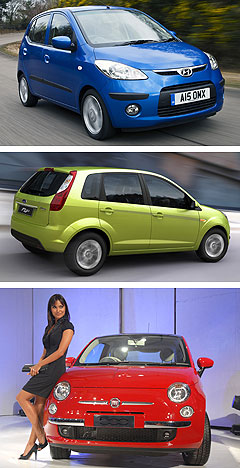India set to be world’s third-biggest car market by 2020
BY TERRY MARTIN | 16th Jun 2011

Despite citing a number of “reasons for caution” about India’s future growth – including government budget and trade deficits and an underdeveloped power generation and distribution infrastructure – JD Power believes car sales will continue to boom in the world’s second-most populous country, in which around 1.2 billion people currently reside.
More bullish than the nine million 2020 sales figure attributed to the Society of Indian Automobile Manufacturers, JD Power’s forecast of 11 million comes after India produced more than 3.7 million vehicles last year – up 33.9 per cent – which made it the second-fastest growing auto market in the world, deferring only to China.
According to JD Power, more than 2.7 million passenger cars and light commercial vehicles were sold in India last year, up from just 700,000 in 2000 and enough to see it move from ninth place – surpassing France, the UK and Italy – in world rankings to sixth overall.
In its ‘India Automotive 2020: The Next Giant from Asia’ report released this week, JD Power said growth in economic activity and the consumer-driven culture that has developed in India over the past two decades should continue apace, with the forecast 11 million sales mark being 6.4 million shy of the expected level for the United States at 17.4 million.

Both, however, will be miles behind China, which is expected to reach 35 million annual light-vehicle sales by 2020.
JD Power and Associates senior vice-president of global automotive operations, John Humphrey, said India’s momentum had been driven by a number of factors, including “a more open and market-driven economy, an empowered and less risk-averse workforce, a more consumer-driven culture and an emphasis on small-car production”.
Just as Thailand has become a global hub for light commercial vehicle production, India is on its way to becoming a global hub for small passenger cars.
This has been fuelled by government incentives for car-makers to build and export small cars from India, as is the case for the Suzuki Alto sold in Australia – and might occur with Hyundai’s i10 – and which has also seen Ford Australia take a lead role in designing and engineering the (previous-generation) Fiesta-based Figo specifically for the Indian market.
Sold through Suzuki Motor Corp subsidiary Maruti – the Indian passenger car market leader – the Alto is also the biggest-selling passenger car in India.
JD Power lists an average transaction price of around $US6200 for the Alto, which compares with an average price of $10,000 across the entire Indian passenger car market. In contrast, China’s average transaction price is $17,500, while in the US it is $28,000.
According to JD Power, last year almost 80 per cent of all new passenger vehicles sold in India were classified as either mini cars or subcompact passenger cars. By comparison, these segments accounted for only 24 per cent of passenger vehicle sales in China in 2010, and just three per cent of sales in the United States.
In an interview for the JD Power report, Tata Motors chairman Ratan Tata – who presides over the Indian auto giant that owns Jaguar and Land Rover, and which has a 50/50 joint venture with the Fiat Group – expressed a need to critically examine the company’s four-year-old association with Fiat to optimise sales of the Italian brand in India.
Overseas news agencies indicate that Fiat sales in India dropped 15 per cent last year, to just over 21,000 units, despite passenger car market growth surging past 30 per cent.
Mr Tata is quoted as saying in the report: “I think that Fiat has to launch more models into the market to keep dealers interested. It also has to look at its cost structure in terms of parts and components. So the joint venture needs to be looked at quite critically and until that happens, it’s not going to be optimised.” JD Power says that India’s “lagging infrastructure” posed the biggest potential obstacle to future growth.
“Much of India’s future growth in the automotive sector will depend on successfully creating the infrastructure to support its economy,” Mr Humphrey said.
He also cited a further problem area: the lack of a broad-based automotive component and parts production industry, as well as a lack of engineering talent needed to carry the automotive parts industry forward.
“Right now, much of the industry still depends on smaller local parts-makers to produce components for vehicles,” he said. “For India to build vehicles of high quality, and in large volumes – especially for export – significant improvements to the components industry will need to be made.” The JD Power report also highlighted that India’s emphasis on small cars is likely to restrict car company profitability in the years ahead, particularly compared to China and the US.
“Should fuel prices continue to climb globally in the future – and as demand for inexpensive and reliable transportation increases in many of the world’s developing markets – India could find itself well-positioned to fulfil the needs of the small-car segment,” said Mr Humphrey.
“That said, profit margins are thinner in the small-car segment, so auto-makers are going to need to manage their businesses carefully to optimise profits.”